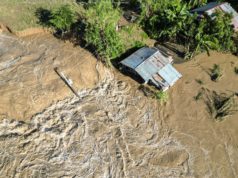Hurricane Irma, which ranked as one of the most powerful Atlantic storms on record before striking the U. S. mainland as a Category 4 hurricane on September 10, has killed at least 84 people. The…
Hurricane Irma, which ranked as one of the most powerful Atlantic storms on record before striking the U. S. mainland as a Category 4 hurricane on September 10, has killed at least 84 people. The Caribbean islands, which includes Puerto Rico and the U. S. Virgin Islands, were hit particularly hard, suffering more than half the fatalities.
As recently as yesterday, about 1.5 million homes and businesses in Florida and Georgia continue to be without power after Hurricane Irma, including 46 of Florida’s nearly 700 nursing homes caught in the deadly storm’s path.
The Florida Keys were severely affected as well. The Florida Keys, a string of causeway-connected islands dangling about 113 miles into the ocean from the tip of the state, took the brunt of Irma’s landfall when the eye of the storm rolled right over the group. Between Islamorada and Stock Island, there are swaths of dramatic wreckage, mostly where the wind and water tossed around trailers, campers, and boats.
While some newer homes constructed according to building codes since Hurricane Andrew in 1992 largely fared well — with their hurricane-resistant windows and living spaces on a second level, the wind damage, as with other parts of south Florida, still managed to take its toll on the trees and power lines, as many were simply no match for the powerful storm.
After the onslaught of the hurricane, Florida residents now find themselves dealing with the rising waters of the Withlacoochee River, that is threatening to bring more devastation. The river is said to be nearing major flood stage at 16.5 feet. Water is reportedly already a few feet over a bridge at Clay Sink Road and State Road 575, and campsites and some residences have been flooded.
Earlier this morning, the Pasco County sheriff’s office shut down Seven Springs northbound lanes at Jenner Avenue due to flooding.
Officials said they see the river moving swiftly and expect it to rise at least another two feet from where it is right now.
Cecilia Patella, the director of Hernando County Emergency Management, spoke on the matter earlier today.
“At this point, I’m going to continue to urge all residents to take emergency protective measures. If you know that you’re in a low-lying area and subject to flooding, I urge you to move away to higher ground as soon as you can.”
Right now, people who live along the Withlacoochee River are still dealing with the aftermath of Hurricane Irma because their homes are flooding. All the rain from Irma is finally making its way into the river which will not be able to hold it all.
This is just the latest in what has been an unfathomably difficult time for residents along the coast.
Irma laid waste to beautiful Caribbean islands and caused historic destruction across Florida. The cleanup will take weeks; recovery will take months. At this point, some islanders just want out. And after a huge exodus from the Florida peninsula, southbound traffic remains heavy with evacuees returning to uncertain situations, many without power or water in sweltering heat and humidity.
[Featured Image by David Goldman/AP Images]






